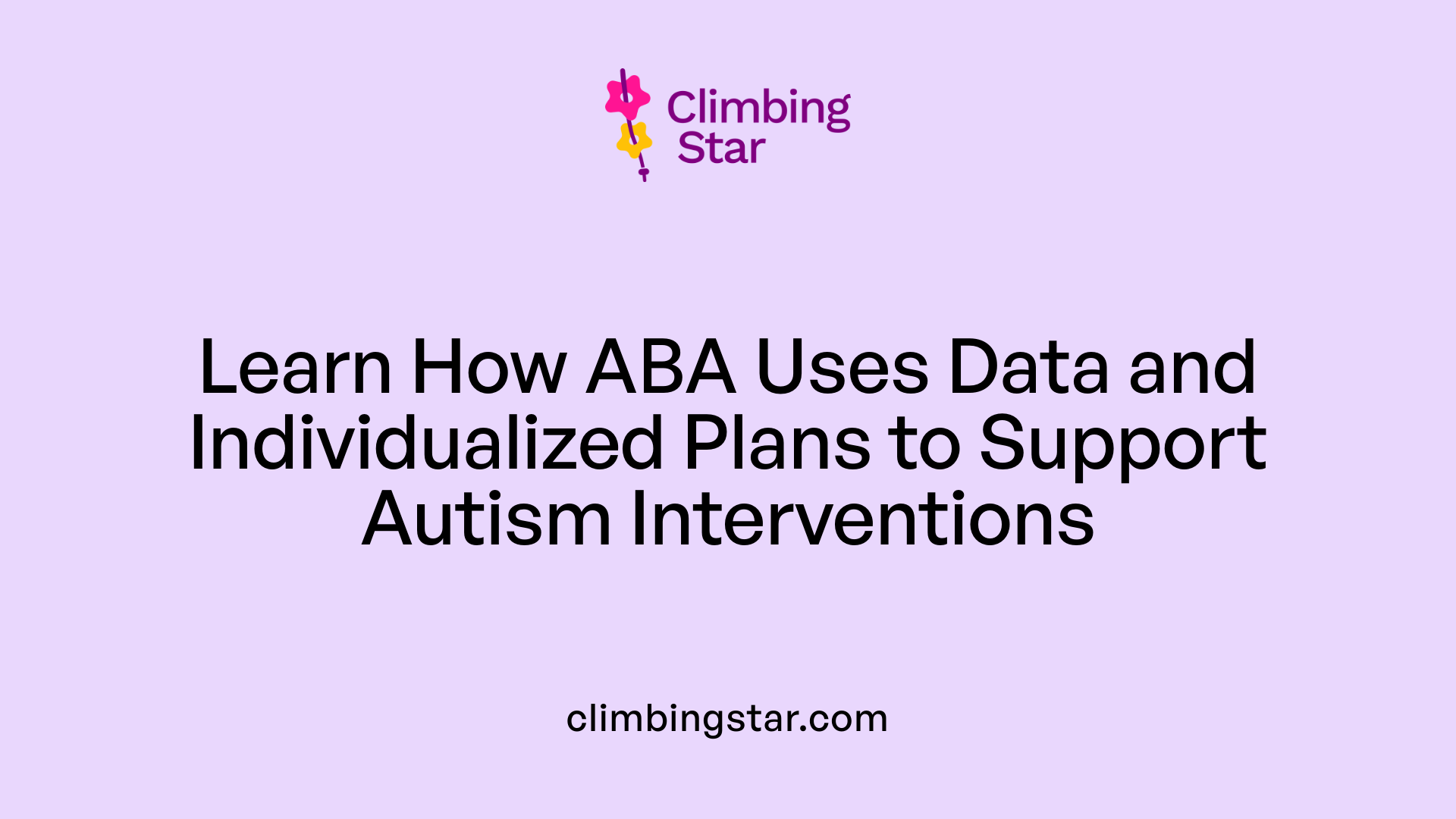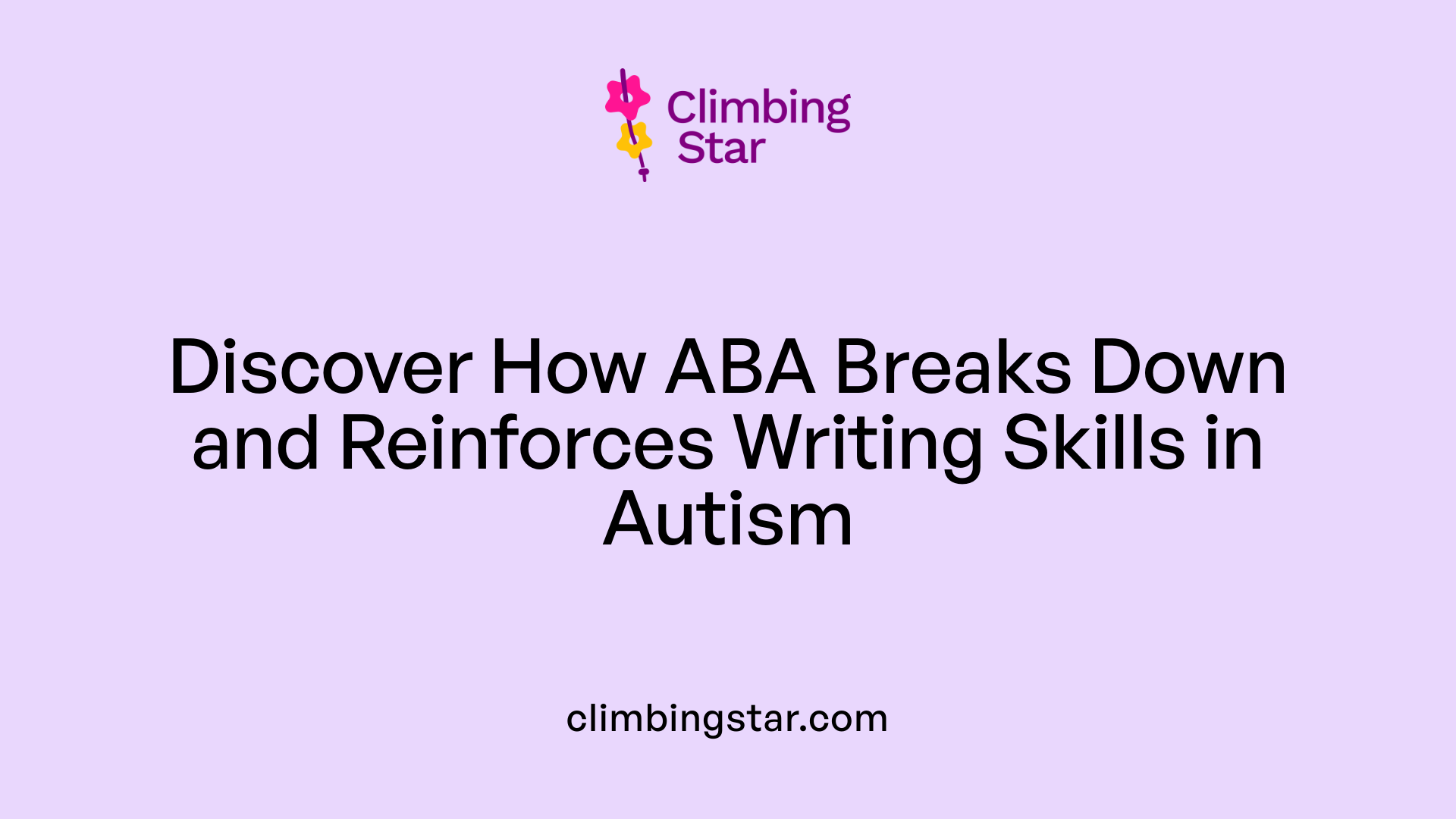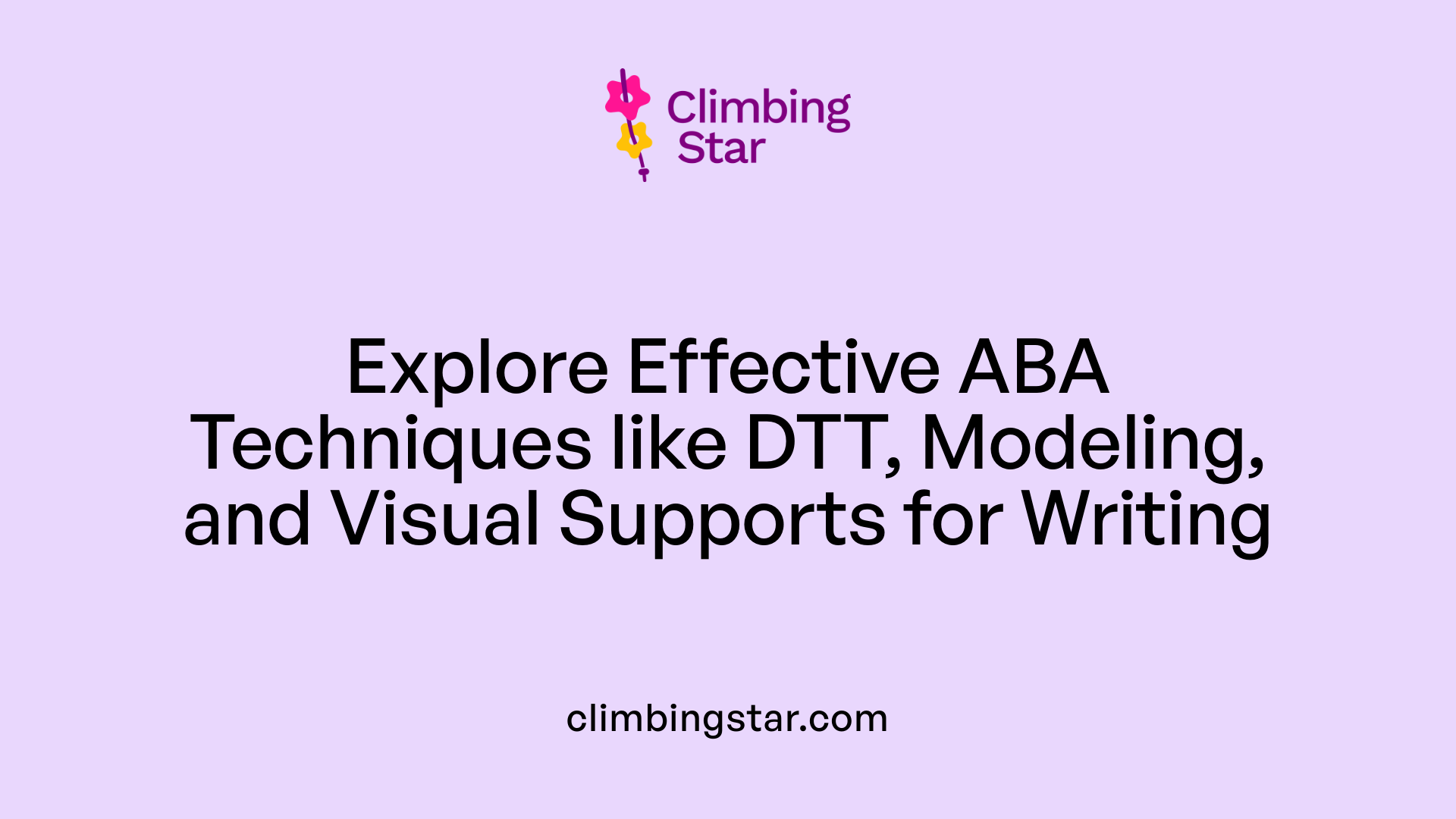Unlocking the Potential of Writing for Students with Autism
Writing is a crucial tool for communication and learning, yet for many students with autism, acquiring this skill presents unique challenges. Applied Behavior Analysis (ABA), a scientifically validated therapy, offers tailored strategies to effectively teach writing by focusing on the principles of behavior, learning, and individualized goal-setting. This article explores how ABA supports writing development in students with autism, outlining techniques, expected outcomes, and the roles of dedicated professionals in this transformative educational process.
Understanding Behavior Analysis Therapy for Autism

What is behavior analysis therapy for autism?
Behavior analysis therapy, most commonly known as Applied Behavior Analysis (ABA), is a science-based treatment focused on understanding and changing behavior through environmental influences. It aims to increase beneficial behaviors including communication, social skills, attention, and academics, while decreasing harmful or unhelpful behaviors. ABA uses strategies like positive reinforcement—rewarding desirable behaviors to make them more likely—and examines what happens before (antecedents) and after (consequences) behaviors to shape lasting change.
Scientific foundation of ABA
ABA relies on the science of learning and behavior, providing measurable, data-driven approaches to therapy. The therapy evaluates behavior through detailed assessments and ongoing data collection. Adjustments in the treatment are made as progress is tracked, ensuring interventions address the individual's needs effectively. The method's evidence-based status is backed by support from the US Surgeon General and the American Psychological Association and over 20 studies demonstrating its effectiveness, especially for children with autism.
Goals of ABA in autism treatment
The primary goal of ABA therapy is to build functional, helpful skills such as language, social interaction, self-care, motor skills, and academic abilities. Simultaneously, it aims to reduce behaviors that may interfere with learning or social participation. Tailored goals are created for each individual, often including communication and play, enhancing overall independence and quality of life.
Individualized program design
Each ABA program is personalized by a qualified Board Certified Behavior Analyst (BCBA). After thorough assessment and with family collaboration, specific goals are identified. Therapy involves teaching skills in small, manageable steps and continuously measuring progress for necessary modifications. This tailored approach ensures therapy meets the unique needs of every individual.
Evolution of ABA approaches
While ABA started with more structured, repetitive methods, it has evolved into naturalistic, play-based, and strength-focused approaches that build on individual preferences and abilities. This progression reflects ongoing discussions about cultural sensitivity, promoting motivation and positive experiences during therapy rather than just compliance.
In summary, ABA therapy is a comprehensive, scientifically supported approach that adapts to each person’s needs, enhancing their ability to lead more independent, fulfilling lives.
How ABA Therapy Enhances Writing Skills in Students with Autism

Teaching Communication and Academic Skills through ABA
ABA therapy supports students with autism by fostering crucial communication and academic skills, both of which are essential for developing writing abilities. By focusing on fundamental skills like language and attention, ABA lays a strong foundation for instruction in written expression.
Breaking Down Writing Tasks
ABA breaks writing tasks into small, concrete steps, making complex activities more manageable. For example, a writing task might be divided into steps such as holding a pencil, forming letters, constructing sentences, and organizing ideas. This step-by-step approach helps students master each component sequentially.
Use of Positive Reinforcement
Positive reinforcement is a core ABA technique that encourages students to repeat desired behaviors. When a student successfully completes a writing step or demonstrates improvement, they receive valued rewards. This reinforcement motivates continual progress in writing skills.
Customization to Student Needs
Each ABA program is tailored to the unique needs of the student. Goals for writing skills consider individual strengths and challenges, and family input is integrated into planning. The customization ensures that teaching methods resonate with the student's preferences and learning style.
Role of Environmental Adjustments
ABA incorporates analysis of antecedents and consequences to optimize the learning environment. Adjustments such as minimizing distractions, providing clear instructions, and creating supportive settings help the student focus and engage effectively during writing exercises.
How Does Behavior Analysis Therapy Help Individuals with Autism?
Behavior analysis therapy, or ABA, helps individuals with autism by scientifically understanding and modifying their behaviors through environmental changes and learning principles. It teaches valuable skills such as communication, social interaction, self-care, and academic abilities by breaking down tasks into small, manageable steps and using positive reinforcement to encourage progress. ABA is highly individualized, with treatment plans tailored to each person's needs and interests, often involving family members and different settings like home or classroom. It aims not only to increase helpful behaviors but also to reduce challenging or harmful behaviors, promoting greater independence and social integration. Robust research supports ABA as an effective, evidence-based approach that can significantly improve various developmental outcomes for children with autism.
Techniques Commonly Used in ABA for Developing Writing Abilities

What techniques are commonly used in behavior analysis therapy for autism?
ABA therapy incorporates several specialized techniques to support skill development, including writing abilities.
Discrete Trial Training (DTT)
DTT breaks skills into small, manageable steps taught one at a time. For writing, this might start with holding a pencil, then forming simple letters. Each trial involves a clear instruction, the child's response, and immediate feedback, helping shape accurate writing skills.
Modeling and Prompting
Therapists demonstrate writing behaviors (modeling) and provide prompts to guide the child’s attempts. Prompts may be physical, verbal, or visual and are gradually faded as the child gains independence.
Positive Reinforcement
Positive reinforcement encourages repetition of desired behaviors. When a child makes progress in writing — for example, correctly tracing a letter — they receive a rewarding stimulus (a praise, token, or activity), increasing motivation to continue practicing.
Functional Behavioral Assessment (FBA)
FBA helps understand challenges that might interfere with writing, such as frustration or avoidance. By analyzing antecedents and consequences of problem behaviors, therapists can adjust strategies to reduce barriers and support successful writing practice.
Visual Aids and Picture Exchange Communication System (PECS)
Visual supports like charts, step-by-step picture guides, or PECS provide clear, concrete cues that assist children in understanding and completing writing tasks. These tools support comprehension and sequencing, crucial for writing development.
ABA techniques are highly personalized, ensuring that writing instruction fits each learner's unique needs and pace. Data is collected continuously to monitor progress and make timely adjustments to teaching methods, maximizing effectiveness.
Role of Qualified Professionals in ABA-Based Writing Instruction

Who provides behavior analysis therapy for autism?
Behavior analysis therapy, also called Applied Behavior Analysis (ABA), is delivered by licensed or certified professionals such as Board Certified Behavior Analysts (BCBAs) and specially trained therapists. These experts bring advanced knowledge in behavior science to design and oversee individualized programs that improve communication, social, and daily living skills.
Assessment and goal setting
Qualified behavior analysts begin with thorough assessments, commonly using tools like VB-MAPP or ABLLS, to determine an individual's current skill levels and needs. This evaluation enables setting clear, personalized goals, including those related to writing skills, ensuring each step builds progressively toward mastery.
Program customization
ABA programs are not one-size-fits-all. BCBAs tailor interventions based on assessment findings and ongoing data collection. For writing instruction, this means breaking down complex writing tasks into manageable parts, using positive reinforcement and repetitive practice to promote learning.
Family involvement
An essential element of ABA therapy is collaboration with families. Professionals incorporate caregiver insights and provide training to support skill generalization across settings, reinforcing writing development outside of formal sessions.
Settings for therapy (home, school, clinic)
ABA interventions occur in multiple environments, including homes, schools, and clinics. This flexibility ensures writing instruction occurs within natural contexts, increasing relevance and promoting consistent skill application.
Qualified professionals play a pivotal role in delivering structured, evidence-based ABA programs tailored to individual needs, maximizing the effectiveness of writing instruction as part of broader behavioral development.
Assessing Progress: Data Collection and Analysis in Writing Development
Why is measurement and data collection important in ABA writing programs?
In ABA therapy, especially in developing writing skills, accurate measurement and systematic data collection are essential. They provide objective information on how well an individual is mastering specific writing tasks. This continuous tracking helps therapists determine the effectiveness of their teaching methods and whether the learner is progressing toward their goals.
How is progress tracked in mastering writing tasks?
Progress is tracked through detailed data on small, concrete steps involved in writing, such as letter formation, spacing, or sentence construction. Each session’s performance is recorded, allowing therapists to see patterns of improvement or challenges. This hands-on approach breaks down complex writing skills into manageable components, making mastery clearer and more attainable.
How do therapists adjust strategies based on collected data?
When data reveal slow progress or difficulties with certain writing tasks, therapists can modify their instructional techniques promptly. Adjustments may include changing reinforcement strategies, breaking down tasks further, or incorporating additional supports. This responsiveness ensures interventions remain effective and personalized.
How does data collection ensure consistent progress?
Consistent data collection fosters accountability and helps maintain momentum in skill acquisition. It creates a feedback loop between the therapist, learner, and family, ensuring that efforts are coordinated and aligned with the learner’s evolving needs.
In what ways does data inform instruction in writing development?
Data analysis guides decision-making by highlighting which writing skills need emphasis and which strategies yield the best results. This evidence-based approach leads to more efficient learning and supports sustained improvements in writing ability.
Expected Outcomes of ABA Therapy on Writing and Communication Skills
What outcomes can be expected from behavior analysis therapy?
Behavior analysis therapy, especially Applied Behavior Analysis (ABA), offers a range of positive outcomes for individuals with autism spectrum disorder and other developmental challenges. One of the most notable improvements happens in communication skills, where ABA strengthens language abilities, social interactions, and the ability to express needs effectively.
Improvements in communication and social skills
ABA therapy helps individuals build stronger language and communication skills by breaking down tasks into small, teachable steps. This structured approach enhances not only verbal communication but also non-verbal cues and social interaction, enabling smoother engagement in both educational and social settings.
Reductions in problematic behaviors
ABA focuses on decreasing harmful or unhelpful behaviors through techniques like positive reinforcement and analyzing what triggers behaviors. This reduction helps individuals better participate in learning activities and social environments without disruptive or unsafe behaviors interfering.
Development of independence in writing tasks
As part of academic skills, ABA supports progress in writing and other motor-based tasks by teaching specific skills in manageable steps and reinforcing attempts and successes. This promotes independence in completing writing assignments and related tasks, boosting confidence and academic participation.
Long-term impact on academics
Consistent application of ABA strategies leads to lasting benefits in academic success. The therapy targets attention, focus, memory, and skill-building that contribute to ongoing learning improvements and readiness for increasingly complex schoolwork.
Enhancement of adaptive functioning
Beyond academics, ABA fosters adaptive functioning — essential life skills for independent living. This includes improvements in self-care, play, social interactions, and emotional regulation, all of which contribute to a more autonomous and fulfilling life.
ABA's evidence-based approach, supported by numerous studies and professional bodies, ensures that progress is carefully measured and therapy plans adjusted accordingly. Overall, ABA therapy can significantly enhance communication abilities, reduce problematic behaviors, and cultivate independence, leading to improved quality of life and educational outcomes for those receiving this treatment.
Navigating Insurance and Access to ABA for Writing Support
How Does Insurance Coverage for ABA Therapy Vary?
Insurance coverage for ABA therapy can differ widely depending on the provider and policy. While many private insurers and Medicaid programs will cover ABA services when they are deemed medically necessary, approval and extent of benefits vary. It is important for families to verify whether their insurance plan includes ABA therapy under its coverage.
What Are the Medical Necessity Criteria for ABA?
To qualify for insurance reimbursement, ABA therapy typically must be prescribed based on a medical necessity determination. This means that a qualified professional must confirm that the therapy is essential for the individual's developmental needs, often supported by diagnostic evaluations and treatment plans.
How Can Families Locate Qualified ABA Providers?
Finding a qualified Board Certified Behavior Analyst (BCBA) is crucial for effective ABA therapy. Families can locate providers through resource guides, recommendations from medical professionals, or autism support organizations. Checking credentials and ensuring that the provider offers programs tailored to individual needs is also important.
What Resources Are Available for Referrals?
Several autism organizations and local health departments maintain directories of ABA providers. Educational consultants and healthcare providers often have referral lists. Online databases also offer searchable listings of certified professionals in specific regions.
What Financial Considerations Should Families Keep in Mind?
Families should consider not only whether insurance covers the therapy but also possible out-of-pocket expenses, session hours covered, and wait times for services. Understanding the billing process, co-pays, and whether providers accept their insurance plans helps manage costs effectively.
Family Involvement and Collaboration in ABA Writing Programs
How Does Parent Training and Support Enhance ABA Writing Programs?
Parents and caregivers play a crucial role in ABA therapy, especially in writing programs. They receive training to reinforce writing skills at home, enabling consistent practice beyond therapy sessions. This support not only boosts the child’s progress but also empowers families to actively participate in the learning process.
Why Is Incorporating Family Feedback Important?
ABA therapists customize writing goals based on detailed assessments and collaboration with families. By incorporating family input, therapists ensure the writing interventions align with the child's daily needs and preferences. This feedback helps to keep targets meaningful and realistic, improving motivation and outcomes.
How Can Writing Skills Be Used in Daily Life?
ABA writing programs emphasize practical application. Techniques taught in therapy are designed to be incorporated into everyday activities, like writing grocery lists or notes, which helps children generalize learned skills. Families support this transfer by encouraging writing in natural settings, reinforcing both communication and self-expression.
What Role Does Collaboration with Schools Play?
Effective ABA writing programs include cooperation with educational staff to integrate therapy goals into the classroom environment. Sharing progress and strategies with teachers helps maintain consistency and allows children to practice writing in academic contexts, enhancing their social and academic success.
How Is Progress Sustained Outside Therapy?
Maintaining writing skills depends on ongoing practice supported by families and schools. ABA therapists guide caregivers and educators with strategies to continue skill-building activities, monitor progress, and adjust plans as needed. This team effort ensures that gains achieved during therapy translate into lasting improvements in writing abilities.
Ensuring Safety, Quality, and Effectiveness in ABA Writing Instruction
What Qualifications and Training Should ABA Staff Have?
Qualified behavior analysts, specifically Board Certified Behavior Analysts (BCBAs), design and oversee ABA programs. They begin with comprehensive assessments to tailor therapy goals to each individual. Staff members should receive extensive training in ABA techniques and ongoing supervision to maintain high standards of care.
What Safety Procedures Are in Place During Sessions?
Safety during ABA sessions is crucial. Providers implement clear procedures to ensure a safe environment, including constant supervision, emergency protocols, and creating supportive spaces where clients feel secure.
How Are ABA Sessions Structured and How Long Do They Last?
ABA therapy sessions are systematically organized to teach skills in small, manageable steps. The duration varies depending on individual needs but generally involves regular, consistent sessions. Providers often tailor the schedule to maximize learning while balancing client comfort and endurance.
How Are Goals Set and Individualized Plans Created?
Goal-setting involves collaboration between the BCBA, clients, and their families. Individualized plans address areas like communication, social skills, self-care, academics, and play. This personalized approach ensures relevance and effectiveness for each learner.
How Is Progress Evaluated and Approaches Adapted?
Progress is closely monitored through ongoing data collection. Regular evaluations help identify successes and areas needing adjustment. BCBAs refine strategies as necessary to optimize outcomes and maintain steady improvement.
These elements collectively guarantee ABA writing instruction is delivered with safety, quality, and responsiveness to individual learner needs, ensuring effective outcomes.
Emerging Trends and Future Directions in Teaching Writing to Students with Autism
What Are Naturalistic and Play-Based ABA Methods?
Naturalistic and play-based ABA approaches focus on teaching writing and other skills in more flexible, engaging settings compared to traditional structured sessions. These methods capitalize on children’s natural interests and everyday environments to promote motivation and generalization of writing skills. By embedding learning opportunities within play and routine activities, these approaches encourage spontaneous communication and creativity.
How Is Technology Being Integrated into ABA for Writing?
Technology plays an increasing role in supporting writing instruction for students with autism. Tools such as tablets, speech-to-text apps, and interactive writing software can enhance engagement and provide immediate feedback. These technologies allow individualized pacing and repeated practice, which are essential for skill acquisition. Moreover, data collection apps help therapists track progress efficiently and tailor interventions.
Why Is Cultural Sensitivity Important in ABA?
Cultural sensitivity and inclusivity have gained attention in ABA therapy. Recognizing diverse backgrounds ensures that writing goals and examples are meaningful and respectful to the individual’s cultural context. This approach fosters better communication and motivation while avoiding cultural biases that could hinder learning or participation.
What Debates Exist Around ABA Best Practices?
Within the ABA community, debates continue around the most effective and ethical practices. Some advocate for more naturalistic approaches over highly structured ones, emphasizing client choice and reducing reliance on repetitive drills. There is also discussion about balancing behavioral techniques with developmental and social-emotional strategies to support holistic growth.
What Innovations Are Seen in Writing Skill Acquisition?
Recent innovations include combining ABA with other evidence-based practices like occupational therapy to address fine motor skills essential for writing. Customized handwriting programs that integrate sensory integration techniques are also emerging. Additionally, incorporating social stories and visual supports helps teach writing in a way that connects more directly with students’ communication and social experiences.
Bridging Communication Gaps Through Targeted Writing Instruction
Applied Behavior Analysis provides a scientifically grounded and individualized framework to effectively teach writing to students with autism. By employing data-driven techniques, positive reinforcement, and collaborative goal-setting, ABA therapy supports development of crucial communication skills and fosters independence. As families and professionals work together, and as the field continues to evolve with emerging best practices and innovations, writing becomes an accessible and empowering tool for students with autism to express themselves and engage meaningfully with the world.
References
- Applied Behavior Analysis (ABA)
- 6 Benefits of ABA Therapy for Children with Autism
- Applied Behavior Analysis (ABA)
- Applied Behavior Analysis (ABA)
- Understanding ABA Techniques: 7 Strategies You Need to ...
- ABA Therapy Examples, Definition & Techniques
- ABA Techniques: Strategies for Behavior Analysts - GSEP Blog
- Applied Behavior Analysis (ABA)
- The Top 10 Reasons Children With Autism Deserve ABA
- Applied Behavior Analysis (ABA)







